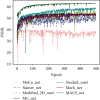Swin Transformer and the Unet Architecture to Correct Motion Artifacts in Magnetic Resonance Image Reconstruction
- PMID: 38725808
- PMCID: PMC11081754
- DOI: 10.1155/2024/8972980
Swin Transformer and the Unet Architecture to Correct Motion Artifacts in Magnetic Resonance Image Reconstruction
Abstract
We present a deep learning-based method that corrects motion artifacts and thus accelerates data acquisition and reconstruction of magnetic resonance images. The novel model, the Motion Artifact Correction by Swin Network (MACS-Net), uses a Swin transformer layer as the fundamental block and the Unet architecture as the neural network backbone. We employ a hierarchical transformer with shifted windows to extract multiscale contextual features during encoding. A new dual upsampling technique is employed to enhance the spatial resolutions of feature maps in the Swin transformer-based decoder layer. A raw magnetic resonance imaging dataset is used for network training and testing; the data contain various motion artifacts with ground truth images of the same subjects. The results were compared to six state-of-the-art MRI image motion correction methods using two types of motions. When motions were brief (within 5 s), the method reduced the average normalized root mean square error (NRMSE) from 45.25% to 17.51%, increased the mean structural similarity index measure (SSIM) from 79.43% to 91.72%, and increased the peak signal-to-noise ratio (PSNR) from 18.24 to 26.57 dB. Similarly, when motions were extended from 5 to 10 s, our approach decreased the average NRMSE from 60.30% to 21.04%, improved the mean SSIM from 33.86% to 90.33%, and increased the PSNR from 15.64 to 24.99 dB. The anatomical structures of the corrected images and the motion-free brain data were similar.
Copyright © 2024 Md. Biddut Hossain et al.
Conflict of interest statement
The authors declare that there is no conflict of interest regarding the publication of this paper.
Figures









References
-
- Sharma S., Hari K. V. S., Leus G. K-Space Trajectory Design for Reduced MRI Scan Time. ICASSP 2020 - 2020 IEEE International Conference on Acoustics, Speech and Signal Processing (ICASSP); 2020; Barcelona, Spain. pp. 1120–1124. - DOI
LinkOut - more resources
Full Text Sources
Miscellaneous

